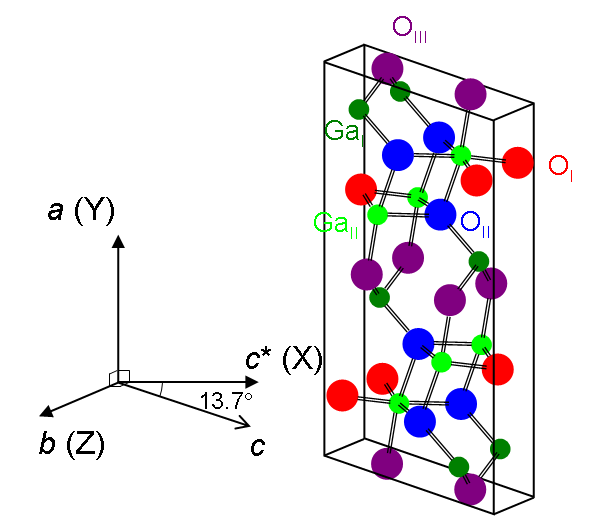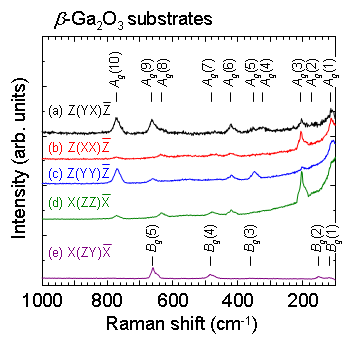Monoclinic β-Ga2O3 has wide-bandgap energy of 4.8-4.9 eV, and has attracted much attention because of their potential use in UV transparent electrodes, photo detectors, substrates for GaN-based light emitters, and field-effect transistors (FETs). [1] Especially, an availability of low cost, large-area, and single-crystalline substrates is great advantage over GaN- and SiC-based FETs. On the contrary, complexity in emission processes in β-Ga2O3 constricts its application for deep UV light-emitters. In this paper, polarized Raman spectra are shown to discuss the relation between lattice vibration modes and emission processes in β-Ga2O3.
Samples investigated are single crystalline a, b, and c-plane β-Ga2O3 substrates grown by floating zone growth [2] or edge-defined film-fed growth methods. Unintentionally-doped (undoped), and intentionally Si-, Mg-, Zn-, or Fe-doped substrates were prepared. Polarized Raman spectra were recorded using JASCO NR-2000 system at room temperature. The samples were excited using a cw Ar ion laser emitting at 514.5 nm with a power of 20 mW. The back-scattered light was dispersed by a triple monochromator, and detected by a charge coupled device.
Relation between crystallographic a, b, c axes and observed X, Y, Z axes for β-Ga2O3 is shown in Fig. 1. The Y- and Z-axes are parallel to the a- and b-axes, respectively, and the X-axis is perpendicular to the ab-plane and is angled at 13.7º from the c-axis; it is abbreviated as c*-axis. The a*-axis is orthogonal to the a- and c-axes. The space group is C2h3. Two formula units are contained in the primitive unit cell. According to the factor group analysis at the Γ point, the irreducible representation for acoustical and optical zone center modes are Γaco=Au+2Bu and Γopt=10Ag+5Bg+4Au+8Bu, respectively. For the optical modes, Ag and Bg modes are Raman active, while Au and Bu modes are IR active. [3, 4] Representative polarized Raman spectra are summarized in Fig. 2. As expected from the polarization selection rules, the Ag modes were observed for the configurations Z(YX)Z, Z(XX)Z, Z(YY)Z, and X(ZZ)X [see Fig. 2(a)-2(d)], and the Bg modes were selectively observed for the configuration X(ZY)X [see Fig. 2(e)]. To the best of our knowledge, this is the first experimental observation of complete set of polarized Raman spectra of β-Ga2O3, in which the polarization selection rules are perfectly reproduced. The results are ensured by the high uniformity of crystalline orientation and surface flatness of the present substrates.
This work was supported in part by Grants-in-Aid for Scientific Research Nos. 23760021 and 21560361 under MEXT, Japan. T. O. is grateful to Prof. M. Sato, Prof. Y. Ito, Dr. H. Nagai, and Ms. C. Mochizuki for their help in the experiments.
[1] M. Higashiwaki et al., Appl. Phys. Lett. 100, 013504 (2012) and references cited therein.
[2] E. G. Víllora et al., J. Crystal Growth 270, 420 (2004).
[3] D. Dohy et al., JSSC 79, 419 (1982).
[4] B. Liu et al., APL 91, 172102 (2007).
Fig. 1 Relation between crystallographic a, b, c axes and observed X, Y, Z axes for b-Ga2O3.

Fig. 2 Polarized Raman spectra of b-Ga2O3 substrates at room temperature. |